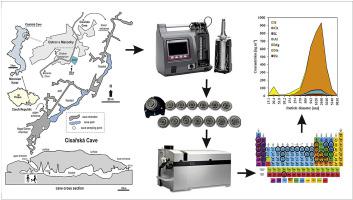Atmospheric Pollution Research ( IF 4.5 ) Pub Date : 2020-04-21 , DOI: 10.1016/j.apr.2020.04.008 Roman Licbinsky , Jiri Faimon , Stefan Tanda , Jitka Hegrova , Walter Goessler , Jarmila Uberhuberova

|
Atmosphere inside caves used for speleotherapy are microenvironments influenced by ventilation and human activities inside. In this context, particulate matter with an aerodynamic diameter from 15 nm to 10 μm was collected with an electrical low-pressure impactor ELPI+ in the Císařská Cave in the northern part of the Moravian Karst (Czech Republic) and 33 elements were determined with inductively coupled plasma tandem mass spectrometry (ICPMS/MS). To see the effect of ventilation, samples were collected with closed and opened entrances.
Nucleation mode particles (particles with aerodynamic diameter less than 10 nm) were dominant in particle number concentrations at both cave ventilation regimes. Aitken mode particles (10–100 nm) differed in the content of sulphur, calcium, iron, chromium, magnesium and nickel for different ventilation regimes. Accumulation mode particles (100–1000 nm) consisted predominantly of sulphur and calcium, also chromium, copper, arsenic, molybdenum, selenium, cadmium and lead were mainly present in this particle size range. Coarse mode particles (larger than 1000 nm) contained predominantly calcium, in addition to common earth crust elements, originating by mechanical abrasion of cave floor.
It is suggested that ventilation as well as children activities in the cave influence the elemental composition of particulate matter, which might have an impact on speleotherapy.
中文翻译:

脾洞中颗粒物元素组成的变化
用于洞穴疗法的洞穴内部气氛是受通风和内部人类活动影响的微环境。在这种情况下,用电动低压撞击器ELPI +在摩拉维亚喀斯特(捷克共和国)北部的Císařská洞穴中收集了空气动力学直径为15 nm至10μm的颗粒物,并通过电感耦合确定了33种元素等离子串联质谱(ICPMS / MS)。为了查看通风的效果,收集了封闭和开放入口的样品。
在两种洞穴通风方式下,成核模式颗粒(空气动力学直径小于10 nm的颗粒)在颗粒数浓度中占主导地位。在不同的通风方式下,艾特肯模式粒子(10-100 nm)的硫,钙,铁,铬,镁和镍的含量不同。堆积模式的颗粒(100-1000 nm)主要由硫和钙组成,在此粒径范围内还主要存在铬,铜,砷,钼,硒,镉和铅。粗模式颗粒(大于1000 nm)除了常见的地壳元素外,主要还包含钙,这是由洞穴底部的机械磨损引起的。
建议通风和洞穴中的儿童活动会影响颗粒物的元素组成,这可能会影响子弹疗法。



























 京公网安备 11010802027423号
京公网安备 11010802027423号